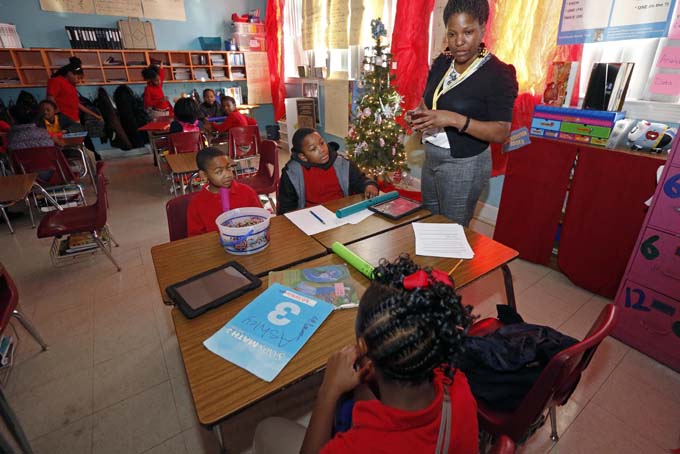
TUNICA, Miss. (AP) — In cotton country a couple miles east of the Mississippi River, just off a road known as the blues highway, fourth graders at Tunica Elementary School are exploring the Delta’s homegrown music to learn about rhythm, rhyme and chord progression.
Their teacher is also using the new Mississippi Blues Trail Curriculum to help the children absorb information in unexpected ways.
Chevonne Dixon is one of the first teachers in the state to incorporate the blues into science, math, social studies and English lessons. So far this school year, the 9- and 10-year-olds in her class have written blues songs about the weather. They’ve composed short ditties about the travails of being a kid. And they’ve read classic blues lyrics to learn the challenges of growing cotton.
“It makes them recall information, especially with that slow, melodic sound,” said Dixon, who leads her classroom with a calm demeanor that brings out a quiet, respectful manner in the children.

Tunica Elementary sits near a milo field just off of U.S. Highway 61, the blues highway that meanders south out of Memphis, Tenn., and down through the cotton and soybeans fields of the flat Mississippi Delta. Tunica County used to be one of the poorest places in the United States, but about 20 years ago the local economy started to perk up with the arrival of casinos on the Mississippi River. Still, Dixon says more than 90 percent of the students in the school qualify for free or reduced lunches — an indication of lingering poverty in a region where many of the children’s parents and grandparents are unemployed or work part-time agriculture jobs.
In 2006, scholars and tourism promoters started working together on the Mississippi Blues Trail, a series of highway markers that provide information about people, places and events significant in developing the hardscrabble music that influenced rock ‘n’ roll. The trail is a magnet for music aficionados, especially European and Asian travelers seeking an off-the-beaten-path experience of American culture — something other than theme parks and big cities.
The Blues Trail Curriculum draws on research that was done for the highway markers. Mark Malone, a music professor at William Carey University, designed the curriculum with help from Scott Barretta, a blues scholar at the University of Mississippi.
The Mississippi Arts Commission made the Blues Trail Curriculum available this school year. It’s aimed at fourth graders who are learning state history, but it can be altered for younger and older students. Its lessons focus on six main areas: music, meaning, cotton, transportation, civil rights and media. And while some traditional blues music has distinctly adult-themed lyrics about drinking, carousing or working for the man, the curriculum presents age-appropriate themes.
On a crisp December morning, Dixon’s classroom is toasty warm. The 16 students wear uniforms of khaki pants with blue, red or yellow knit shirts. They quickly go from wiggly to quiet as Dixon clicks on a recording of Malone singing “Homework Blues,” accompanied by simple piano notes. It is call and response — he sings a phrase, the children echo it:
“I have lots of homework now… Social studies, science and math, oh wow.”